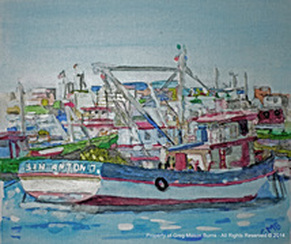
Watercolor paint: Puerto de San Antonio – Watercolor on Board (2014)
What is Watercolor Paint
As one might guess, watercolor paint is water-based, made up of pigments (color), gum arabic (binder), additives (to improve the quality), and solvent (dilutant). It’s the binder that makes it watercolor. Paints are usually sold in either tubes or pans (half or full pans). Tubes are generally considered more convenient, but pans have their place as well.

Colonia del Sacramento – Watercolor on Paper (2014)
Transparency
The feature that I like most about watercolor paints, as noted above, is transparency. This means that light shines through the paint and allows one to see the white of the paper underneath. With this, it means that layering is something that is quite common when using watercolor paints. In other words, the original color changes with a new color painted over it, all the while the color of the paper still shines through. I also like this transparency because the original drawing is still visible after adding the paint on top of it, thus allowing for harder lines where the paint spreads out (at least that’s what I like about it).
Process
How do I work? My technique is to first lay down the masking fluid in areas where I want to preserve the white of the paper. And actually, I use masking fluid to preserve areas that I don’t want to layer but I won’t leave white as well. In Colonia del Sacramento I used it to block out the colors of the roof while I laid other colors down first. Then I draw out the image. I use charcoal, and while that may not be the preferred material to use with watercolor as a result of it blending with the paint, I actually like this and use the wet charcoal to help darken the color.
From there, I use a lot of water and lay down very light washes first. I leave everything as light as possible just in case I make a mistake and want to lift out the color after. It also gives me a chance to build the painting up over time. I’m an oil painter first after all, but for me, building a painting over time allows me to watch it develop, and to see how the dark and light work with each other.
Brands
I personally paint with Winsor and Newton Professional Water Colours, and while I understand why the student might want to stay cheap and play with student-grade paints, I don’t recommend doing this. In fact, I recommend using professional-grade paints with all different types of paint (oil, acrylic, watercolor, gouache, etc.). You can only create a painting once, so why not learn with professional-grade materials? In the end, after learning with student-grade materials one will have to learn how to use the new professional-grade materials all over again (yes, the results are different because of the materials). Other top-quality paints are: Sennelier, Schmincke, Daler-Rowney, Daniel Smith, and M. Graham, among others.I hope this helped you understand watercolor paints better.